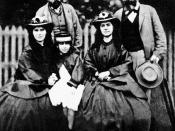Jenny and Eleanor Waldorf from a scene on ÃÂGossip GirlÃÂ TV ShowINTRODUCTIONThe introduction chapter constitute of general overview of the beginning observation and phenomenon about the topic in this report.
Problem IdentificationThe problem identification consists of explanation about the conflict (the symptoms) that is happen at the moment. The problem is:Jenny is an intern in Eleanor Waldorf design house. Eleanor is a very famous designer and Jenny is one of the interns that have great work performance in Eleanor Waldorf design. Even one of Jenny own design is used by Eleanor as one of EleanorÃÂs design (accidentally).
Because of the piling amount of work, Jenny that is still in high school cannot keep up with the work and the school. Jenny skip school a lot and she did not obey her dad command to end her intern and just go to school. Jenny really love fashion and being an intern at Eleanor WaldorfÃÂs will give her such a big chance to be a new designer in the fashion world.
By being an intern for Eleanor Waldorf, she could learn lots of things about the fashion world. At the end, Jenny and her dad decided to do home schooling, instead of going to school. With home schooling, Jenny can do both intern work and still attend school at home.
However, after several months being an intern for Eleanor Jenny feels that she cannot expanding her knowledge in fashion, let alone give her contribution to EleanorÃÂs design. She only sews dress and fit the model into the dress. And sometimes Eleanor use JennyÃÂs design without putting JennyÃÂs name into the designer. She only told Jenny to sew a new dress using JennyÃÂs design and EleanorÃÂs fabric. Jenny feels that Eleanor did not appreciate her at all.
One time, Eleanor has a meeting with the owner of BarneyÃÂs, one of the biggest high-end department stores in the United States and promise Jenny to come to the meeting because Eleanor has use JennyÃÂs design. However, when the meeting is held, Eleanor said that Jenny cannot join the meeting since Jenny is not experienced enough and still a child. This has happened twice. Finally, Jenny threatens Eleanor that if she keeps using JennyÃÂs design (and it became most favorite dress) with EleanorÃÂs name and did not let Jenny join the meeting with BarneyÃÂs and other high-end department store, Jenny will quit the interns.
However, Jenny knows that if she quit the interns her dad will be so mad at her since she quit school already. In addition, Jenny did not have the source and money to start her own clothing line, even though one of the models, Agnes, said that she could help Jenny to start a clothing line.
Option, Position, Threat and Preferences IdentificationCharacters description and their optionsEach character has option that is available, which are:Jenny (J, EleanorÃÂs Intern)Leave internshipStay in the internshipMake JennyÃÂs own clothing lineEleanor (E, the founder and owner of Eleanor Waldorfs line)Give Jenny chance to join the meeting with the owner of high-end department storePosition DescriptionJennyÃÂs position is that actually she did not want to quit her internship with Eleanor since she already quit school in order to be EleanorÃÂs intern. However, Jenny do want to make her own clothing line but Jenny feels now its not the right time since she did not have enough experience in the fashion business. Right now, all Jenny wants is to join the meeting with BarneyÃÂs and other high-end department store with Eleanor to broaden her connection for her plan to make her own line, later on.
EleanorÃÂs position is she did not want Jenny to leave the internship and she did not want Jenny to join the meeting with BarneyÃÂs and other high-end department store because JennyÃÂs name would be known and it would be easier for Jenny to make her own clothing line. EleanorÃÂs only want Jenny to be an intern and use her great design with EleanorÃÂs name.
Threat DescriptionThreat that Jenny gives to Eleanor is that she will quit the internship if Eleanor do not stop using JennyÃÂs design with EleanorÃÂs name and do not let Jenny to join the meeting with the high-end department store.
In this case, Eleanor does not have threat for Jenny but she knows that Jenny already sacrifice a lot (quit school and fight with her dad) to be an intern in her design house. Therefore, Eleanor thought that Jenny would not dare to quit the internship.
Preferences DescriptionJenny first preference is JennyÃÂs own position (to stay as an intern at Eleanor and given the chance to join the meeting with high-end department store), her second preference is to leave EleanorÃÂs and start her own line with Agnes help and the least preferred is to leave Eleanor to stop Eleanor take her design.
Eleanor first preference is EleanorÃÂs own position (keep JennyÃÂs internship and keep Jenny out of the meeting with high-end department store), her second preference is to give Jenny chance to join the meeting and Eleanor least preferred that Jenny leave the firm, which make Eleanor could not use JennyÃÂs design and the possibility for Jenny to make her own clothing line.
FRAME ESTABLISHMENTIn this chapter, the common reference frame from the problem explained in the previous chapter will be form. The common reference frame consists of position, threat and preferences from each character.
SHAPE \* MERGEFORMATFigure 1. Common Reference FrameGeneral Explanation on Common Reference FrameOn the left side of the matrix, there are characters that involve in the conflict, and each character have her options that located below the name; for example Eleanor have one option, which are ÃÂgive Jenny chance to join the meetingÃÂ.
The matrix above illustrates various scenarios that may take place as the result of characters interactions, which consist of positions that offered by each character (appropriate with the characterÃÂs name abbreviation, for example the J column represents JennyÃÂs character position). The characterÃÂs position is the scenario that offered by a character to the other, and this offer is a public position that makes all characters involve in this matter could see the position.
A position means one alternative combination of adoption, rejection or abstain from each option of each characters involve in the conflict. For example, in Figure 1 it can be describe that J position is adopted to ÃÂstay in the internshipÃÂ and for E to ÃÂgive her chance to join the meetingÃÂ and also rejected to ÃÂleave the internshipÃÂ and make ÃÂJennyÃÂs own clothing lineÃÂ. Beside position, there is also threat that illustrates the future scenario that will happen if the characters take the threat into actions.
DILEMMA IDENTIFICATIONIn this part, the dilemma experiences for each character are identified. In negotiation, dilemmas that will be face by each character will emerge, and it would obstruct the resolution to take place (Bryant, 2003). There are two group of dilemma that take place in the negotiation process:Confrontation DilemmaThis dilemma happen in the condition where all characters involve in the conflict does not have the same position/offer/suggestion (or at least there is one character that have the different position that is not compatible with the position of the other charater), which cause the character that experience the dilemma does not credible in applying its threat, which are:Threat dilemmaCharacter 1 face threat dilemma towards character 2 if the threat from character 1 is not taken seriously (not credible) by the character 2, since character 2 know that there is other future scenario other than character 2 position that is prefer by the character 1 than the characterÃÂs 1 threat. Character 1 is only considered bluffing by the other character. In this condition, character 1 needs to make his or her threat more credible, with using negative emotion such as anger, hatred or infuriation.
Rejection dilemmaCharacter 1 will face rejection dilemma towards character 2 if there is an obstacle for character 1 for trying to convince the other character that he or she is serious in rejecting the position of character 2, because maybe character 1 is seems to prefer the character 2 position rather than characterÃÂs 1 threat position. In this condition, character 1 needs to make his or her threat to look more credible with negative emotion as explained before in the threat dilemma.
Positioning dilemmaCharacter 1 will face positioning dilemma towards character 2, if character 1 prefers the character 2ÃÂs position than his or her own. Character 1 may reject character 2ÃÂs position in order to get better offer or it is may happen due to character 2ÃÂs position is considered unrealistic or it is may be because character 1 prefer the threat position rather than characterÃÂs 2 position or maybe because character 1 does not believe in character 2.
Persuasion DilemmaCharacter 1 will face persuasion dilemma towards character 2 if character 1 prefers character 2ÃÂs position rather than the threat, which cause character face some obstacles in convincing character 2 to accept character 1ÃÂs position.
Collaboration DilemmaIf the confrontation dilemma is succesfully eliminate, consequently the characters that interacting to each other will have the same position (which means there is no difference in the importance of the offered position). However, they could still face the collaboration dilemma, which make each character do not trust each other regarding the comitment on the same position.
Trust dilemmaCharacter 1 will face trust dilemma towards character 2 if character 1 is unsure that character 2 will commit to the same position. In this case, character 1 could also move to other position, or find a way to make he or she sure with character 2ÃÂs commitment.
Cooperation dilemmaCharacter 1 will face cooperation dilemma towards character 2 if character 1 is also influence to get out of the commitment due to the possibility of future scenario that is more interesting than the commitment. If character 1 wants to eliminate this dilemma, character 1 could move to the other position or character 1 could try to convince character 2 to stay commit to the same position.
Based on the dilemma definition that explained above and the common reference frame on chapter 2 , a meditor could analyze the dilemmas that face by each character. The dilemma face by the character involve in this case is illustrated on the table below:Table 1. Dilemma Interaction Between Each Characterwith respect toDilemma ofJenny (J)Eleanor (E)Jenny (J)TDEleanor (E)PD& RDNotes:TD: Threat DilemmaPD: Persuasion DilemmaRD: Rejection DilemmaWith respect to the common reference frame in Figure 1 and the dilemma definitions, the dilemmas illustrated in Table 1 is explained below:Jenny (J) has:Threat Dilemma towards Eleanor (E), that is JennyÃÂs rejection towards EleanorÃÂs position (E) in not credible on EleanorÃÂs point of view due to EleanorÃÂs (E) know that there is other future scenario other than EleanorÃÂs position that Jenny (J) prefers than JennyÃÂs threat (t) position. Jenny (J) is only considered bluffing by Eleanor (E) since Jenny (E) assumes that Eleanor (E) knows that Jenny (J) has sacrifice a lot for the internship and will not leave the internship just like that.
Eleanor (E) has:Rejection Dilemma towards Jenny (J) since EleanorÃÂs (E) rejection of JennyÃÂs position is not credible. This is due to Jenny believes that Eleanor may prefer JennyÃÂs position to the threatened future.
Persuasion Dilemma towards Jenny (J). In this case, Eleanor (E) prefers JennyÃÂs position rather than the threat (t). Eleanor (E) will face obstacles in convincing Jenny (J) to stay in the internship without being able to join the meeting. EleanorÃÂs problem is that Jenny rejects her position and prefers the threatened future under which Eleanor must choose to give Jenny (J) the permission to join the meeting or not.
FRAMEWORK SUGGESTIONIn this chapter, based on the suggestion of the framework change (such as give permission for Jenny to join the meeting with high-end department store since Jenny is such a hardworker and creative interns), they way of a meditor work on this matter is illustrated. In addition, the change in dilemmas experience by each characters and the compatibility between the new position are also analyze. If the dilemmas are still experience by the characters involve in this matter, then the mediator will propose another new framework and so on and so forth until the dilemma-free frame could be establish and cooperative relation will produce between each characters involved.
The Frame Change Suggestion to Eliminate DilemmaTo produce the combination of sugeestion that is comprehensive hence, able to reduce or even eliminate the dilemmas that explained above, a mediator has to understand how the dilemmas from each characters (that derived from the position of each characters) interact with each other so that the new (and better) position for each character could be creatively formulate. Consequently, the amount of the dilemma could be reduce, or even eliminate.
The dilemmas interaction between each character involve in this matter could be see in Table 1. The compatible position in this conlict could be the measurement of the level of conflict in this matter, Two Two position that offered by two characters are said to be compatible if there is no rejection on the position that offered by the other character. In other words, all characters should have the same position. In this case, the compatibility between character J and E is illustrated on the Table 2 below.
Table 2. Position Compatibility between character J and Ewith respect toDilemma ofJenny (J)Eleanor (E)Jenny (J)Eleanor (E)Notes:â means position between two different characters are compatibleThose dilemmas take place because Eleanor insisted thar she would not let Jenny to join the meeting with the high-end department store. If Eleanor and Jenny could sit together and discuss and communicate about this matter, they could do conciliation or compromise action and both parties give positive emotion to each other this matter could be solve and the dilemmas could be eliminate. In addition, if Jenny gives her intention to Eleanor that if Eleanor give her permission to join the meeting then Jenny will not leave the internship the conflict could be solve without confrontation.
Frame ChangesDue to the suggestion of the new framework that explained above, several options and position from each characters change. Consequently, the new framework is formed. The illustration of the framework change could be seen on Figure 2.
Figure 2. The New Common Reference FrameBy comparing Figure 1 and Figure 2, the changes in each characterÃÂs position, changes in each characterÃÂs option, threat position and preferenceÃÂs of each characters could be obesrved. The result of dilemma analysis from the new frameworks is illustrated on Table 3 below.
Table 3. Dilemmas interaction between characters from the new framewith respect toDilemma ofJenny (J)Eleanor (E)Jenny (J)Eleanor (E)Table 3 shows that the new frame suggestion significantly eliminate the dilemmas that occured in the case beforehand. The dilemmas reduced from two to none. Therefore, the new framework suggestion is very succesful in eliminating the dilemma.
PositionÃÂs compatibility between each character from the new formed frame could be observed on the Table 4.
Table 4. PositionÃÂs compatibility between each characters from the new framewith respect toDilemma ofJenny (J)Eleanor (E)Jenny (J)âÂÂEleanor (E)âÂÂCONCLUSIONBased on the analysis that is done using the model explained above, the writer concluded that to solve this matter Eleanor should compromise and give Jenny the permission to join the meeting with the owner of the high-end department store in the United States (such as BarneyÃÂs, Saks Fifth Avenue, and et cetera) since Jenny is a really hardworking and creative intern. Even Eleanor sometimes uses JennyÃÂs design her own. In addition, Jenny has sacrificed a lot to be an intership for Eleanor (Jenny quit high school, fights with her dad and attend home school at the end). Therefore, Eleanor is suppose to appreciate Jenny more by give Jenny more chance and education in the Fashion Business. With this collaboration and communication, the dilemma that once occurred between Eleanor and Jenny could be eliminated.
If Eleanor does not want to compromise and stay on her position, Jenny could really leave the internship and start her own line with Agnes. This may be good for Jenny at the beginning, but the dilemmas are still experience by each characters and the problem is not resolved. In addition, the future scenario may not be good for Jenny because there is a possibility for Jenny to be use by Agnes. Consequently, Eleanor and Jenny should communicate and compromise in order to resolve the conflict, eliminate dilemmas and the mutualism relation between each party would be establish (win-win negotiation).
REFERENCEGunawan AW, Achmadi SS, Arianti L. 2004. Pedoman Penyajian Karya Ilmiah. Bogor: IPB Pr.
HYPERLINK "http://abacus.bates.edu/~ganderso/biology/resources/writing/HTWgeneral.html" http://abacus.bates.edu/~ganderso/biology/resources/writing/HTWgeneral.htmlMichelle Malese. 2003. Negotiation. http://www.beyondintractability.org/essay/negotiation/Wikipedia. 2008. Drama Theory.
http://wiki.drama-theory.com/wiki/Drama_TheoryThe CW TV. 2008. Gossip Girl Episode.
http://www.cwtv.com/shows/gossip-girl/episodes/208





